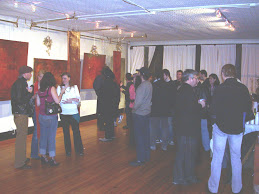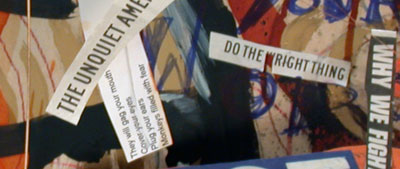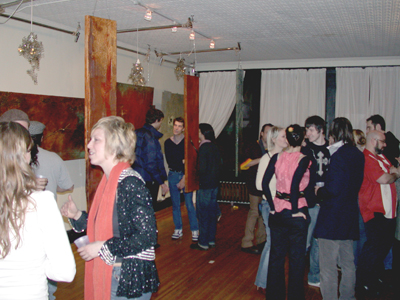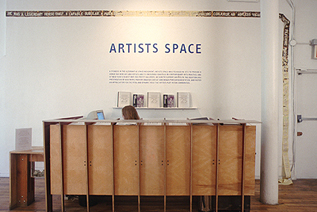FROM THE ILLUSTRATORS’ PARTNERSHIP
Both House and Senate versions of the Orphan Works Act of 2008 can be downloaded from the IPA homepage:
illustratorspartnership.org/Many groups are coming together to oppose this bill. We’re preparing letters you can customize and send to your representatives through our push-button link. Please stay tuned and we’ll give you the tools we need to make our voices heard.
For additional background on Orphan Works, go to the IPA Orphan Works Resource Page for Artists
illustratorspartnership.org/01_topics/article.php?searchterm=00185 Visual Artists Copyrights Under Attack:
Open letters from Brad Holland and Cynthia Turner
Forwarded by Walter King
I am forwarding these letters to all of you at Absolutearts and the various feeds they service. This issue is of great importance to all visual artists as well as anyone who regularly creates and provides creative content and intellectual property for publication in any form.
Brad Holland and Cynthia Turner have been working on this issue for quite some time. When I was the Chair of Illustration at the Columbus College of Art and Design CF Payne brought the issue of artist rights to me. Together we organized a round table discussion giving early exposure to an issue of great importance to all artists. The dialogue on illustrators rights and the need for an organization to help educate artists and help illustrators protect their rights was beginning to resonate. That was more than10 years ago. Shortly after that round table a biennial Illustrators Conference was established igniting a debate on the issue of stock art companies, copyrights and collecting societies. Shortly after that the Illustrators Partnership was forged separately. The Partnership has come to maturity during the last decade in which copyright issues have come to the forefront because of contemporary business models and the confusion caused by the internet. Brad testified before Congress a while back helping to defeat the previous version of this upcoming bill. He feels that this next version has strong support in both houses and might pass. The letters are very informative. Especially the last part of the second letter which clearly shows why this issue is important to visual artists. Certainly Illustrators should be aware but all visual artists essentially will be affected.
You don’t need to be set up to sell copyrights professionally for this to be an issue for you. Just the fact that you publish your work on the web could become a problem allowing infringers to use your work with out paying for it. I encourage every visual artist to read both letters carefully. Do some further copyright research on the net. You'll be surprized how many myths there are out there that we've all bought into. Get educated about perhaps the most important issue to affect your work since the creation of the personal computer and the internet during the last century.
Be prepared to write your Senators and Congressmen to express your concerns about this bill when it appears.
Walter King
More from Brad Holland and Cynthia Turner
From: illustratorspartnership@cnymail.comSubject: "Promoting" Orphan WorksDate: Fri, 14 Mar 2008 18:28:51 -0400
FROM THE ILLUSTRATORS’ PARTNERSHIP
Yesterday ( Thurs. Mar. 13, 08) the House subcommittee on Intellectual Property held their first hearing on new Orphan Works legislation. Note the title:
"Hearing on Promoting the Use of Orphan Works: Balancing the Interests of Copyright Owners and Users"
http://judiciary.house.gov/oversight.aspx?ID=427
Balance, however doesn’t seem to be part of the Orphan Works juggernaut. Indeed, after this hearing, we can no longer assume that the U.S. Copyright Office is an advocate for the protection of creators' rights. As they wrote on page 14 of their original Orphan Works Report:
"If our recommendation resolves users’ concerns in a satisfactory way, it will likely be a comprehensive solution to the orphan works situation." (our emphasis)
But how can any copyright law be "comprehensive" if it makes millions of copyrights, no matter how valuable, available to users, no matter how worthy, under a system that would introduce permanent uncertainty into the business lives of creators?
Private Sector Registries
Since the last bill died in committee in 2006, the advocates of this legislation have promoted the creation of private commercial registries. On January 29, 2007, a lead attorney for the Copyright Office warned us that under their plan any work not registered with a private sector registry would be a potential orphan from the moment it was created.
This means you would not only have to register your published work, but also:
— Every sketch or note on every page of every sketchbook;
— Every sketch you send to every client;
— Every photograph you take anywhere, anytime, including family photos, home videos, etc.;
— Every letter, email, etc., professional, personal or private.
This Would End Passive Copyright Protection: Under existing law the total creative output of any "creator" receives passive copyright protection from the moment you create it. This covers everything from the published work of professional artists to the unpublished diaries, letters and family photos of the average citizen.
But under the Orphan Works proposal, none of this material would be covered unless the creator took active steps to register and maintain coverage with a commercial registry. Failure to do so would "signal" to infringers that you have no interest in protecting the work.
The Registration Paradox: By conceding that their proposals would make potential orphans of any unregistered works, the Copyright Office proposals would lead to a registration paradox: In order to "protect" work from exposure to infringement, creators would have to expose it on a publicly searchable registry. This would:
— Expose creative work to plagiarists and derivative abusers;
— Expose trade secrets and unused sketches to competitors;
— Expose unpublished and private correspondence to the public on the Orwellian premise that you must expose it to "protect" it.
Yet registries will not be able to monitor infringements nor enforce copyright compliance. Even after you’ve shelled out "protection money" to a commercial registry to register hundreds of thousands of works, you still won’t be protected. A registry would do nothing more than give you a piece of paper. You would still have to monitor infringements - which can occur anytime anywhere in the world; then embark on an uncertain quest to find the infringer, file a case in Federal court, then prove that the infringer has removed your name or other identifying information from your work. Meanwhile all the infringer will have to do is say there was no such information on the work when he found it and assert an orphan works defense. This will be the end result of trying to "resolve the users’ concerns" at the expense of time-tested copyright law.
Coerced registration violates the spirit and letter of international copyright law and copyright-related treaties. And because this bill would effectively eliminate the passive copyright protection afforded personal correspondence, family photos, etc. it would tear one more slender thread of privacy protection from the fabric of fundamental rights we currently take for granted.
We urge Congress to carefully reconsider the unintended consequences of this radical copyright proposal.
— Brad Holland and Cynthia Turner, for the Board of the Illustrators’ Partnership
Please post or forward this email in its entirety to any interested party
From: illustratorspartnership@cnymail.comSubject: Orphan Works: IPA Written StatementDate: Thu, 20 Mar 2008 23:21:03 -0400
FROM THE ILLUSTRATORS’ PARTNERSHIP
Concerning Orphan Works Legislation
Written Statement of Brad Holland and Cynthia Turner on Behalf of the Illustrators’ Partnership of America
The Subcommittee on Courts, the Internet and Intellectual Property
Committee on the Judiciary
U.S. House of Representatives
March 20, 2008
Mr. Chairman and Members of the Subcommittee, while this statement is being filed by the co-chairs of the Illustrators Partnership of America, it reflects a statement previously submitted to the Copyright Office and endorsed by 42 national and international organizations representing a broad spectrum of the commercial and fine artists who make their living from the exercise of the exclusive rights guaranteed to them by the U.S. and international copyright law and treaties.
We respectfully request that the subcommittee delay any action on the pending legislation until we have been able to inform its members fully about our concerns and to work with the subcommittee to address those concerns. It then may be possible to craft legislation that does not unfairly prejudice the interests of those whose livelihood depends on meaningful copyright protection. We also are concerned that the legislation, as drafted, may have spillover effects on a wide variety of copyrighted works that are important to a growing and healthy U.S. economy in the information age.
Under this legislation, as we understand it, effective copyright control to a work, including works of visual art, would require submission of a copy or copies of the work to as yet-to-be created private registration companies that would use untested technologies to scan images submitted by unlicensed users. These users would then be excused from any liability for infringement unless the legitimate rights holder responded within a certain period of time to grant or deny permission to use the copyrighted work. This is a radical departure from any existing business models or practices in the field of copyright.
Further, it radically abridges the fundamental principal of exclusive rights granted to creators under the copyright law, and creates a sweeping compulsory license permitting large scale unauthorized use of not only older works, the provenance of which may be difficult to determine, but also of the valuable contemporary works that are the economic life blood of those in our profession. U.S. copyright law currently contains a number of statutory licenses that legitimize either de minimus use of a work created principally for other uses, or that deal with the special needs of not-for-profit organizations and others that skirt the boundaries of fair use. However, all of these statutory licenses provide for a system of remuneration to the copyright owner for uses that have not been directly authorized. This legislation is neither limited to de minimus uses of works nor does it provide a method of compensation for such uses.
The cavalier disrespect for the fundamental principle of exclusive authors’ rights that is inherent in the Copyright Office’s legislative scheme is reflected in the following colloquy between this author and the General Counsel of the Copyright Office at a meeting in which he responded to the concerns of visual artists about the potential harmful effects of this legislation.
Holland: If a user can’t find a registered work at the Copyright Office, hasn’t the Copyright Office facilitated the creation of
an orphaned work?
Carson: Copyright owners will have to register their images with private registries.
Holland: But what if I exercise my exclusive right of copyright and choose not to register?
Carson: If you want to go ahead and create an orphan work, be my guest!
(From the author’s notes of the meeting.)
We believe strongly that this legislation as now written violates the obligations and commitments of the United States under Article 5 (2) of the Berne Convention on Literary and Artistic Rights which states:
"The enjoyment and the exercise of these rights shall not be subject to any formality." (Emphasis added)
This Berne Convention principle has been incorporated into the Universal Copyright Convention and Article 13 of the Agreement on Trade-Related Aspects of Intellectual Property Rights (TRIPS). These agreements acknowledge narrow limitations and exceptions to the exclusive right of copyright – so long as the exceptions don’t exceed the constraints of the TRIPS Three-Step Test:
"Member [countries] shall confine limitations and exceptions to exclusive rights to:
(1) certain special cases
(2) which do not conflict with a normal exploitation of the work
(3) and do not unreasonably prejudice the legitimate interests of the rights holder."
Legal scholars Jane Ginsburg and Paul Goldstein have warned that Orphan Works legislation must precisely define the scope of its mandate or fail to meet the three-step-test. As they wrote in their submission to the Orphan Works Study:
"[T]he diversity of [orphan works] responses highlights the fundamental importance of precisely defining the category of "orphan" works. The broader the category, or the lower the bar to making the requisite showing of due diligence, the greater the risk of inconsistency with our international obligations to uphold authors’ exclusive rights under copyright. Compliance with Berne/TRIPs is required by more than punctilio; these rules embody an international consensus of national norms that in turn rest on long experience with balancing the rights of authors and their various beneficiaries, and the public. Thus, in urging compliance with these technical-appearing rules, we are also urging compliance with longstanding practices that have passed the test of time." 1., p. 1, OWR0107-Ginsburg-Goldstein (Emphasis added).
We do not believe the Copyright Office proposals address the concerns of professors Goldstein and Ginsburg and would, if enacted, subject the United States to complaints of treaty non-compliance at the World Trade Organization. And, we would expect the international reprographic and artists rights societies which endorsed our submissions to the U.S. Copyright Office would be able successfully to encourage their governments to bring such complaints.
As the world’s leading creator and exporter of copyrighted works, the credibility of efforts of the United States to secure effective international enforcement of copyright would be materially weakened by the enactment of this proposed legislation. Certainly any law that prevents effective remedies or imposes arbitrary burdens on the right to bring infringement actions – much less provide for compensation for de minimus uses – would be seized upon by those in other countries who wish to defend piracy of U.S. works.
In addition to our concerns about the compulsory licensing aspects of this legislation we would like to acquaint the subcommittee with the unique characteristics of illustration and other visual works of art that distinguish us from those who create other categories of copyrighted works such as literary works, songs and films. Unlike these other categories of works, works of visual art lack universally accepted titles that would allow users to search for them by name. Therefore the role of image recognition technology is critical. This technology is still in its infancy, is untested, and its use raises a number of very practical concerns. Among these concerns:
- The number of works created by the average visual artist far exceeds the volume of the most prolific creators of literary, musical and cinematographic works;
- The cost and time-consumption to individual artists of registering tens of thousands of visual works, at even a low fee, would be prohibitive; therefore
- Every artist would see thousands of his creations potentially orphaned from the moment of creation.
- No registry would be meaningful until billions of pre-existing works (both published and unpublished) from artists (both living and dead) have been digitized; but
- Few, if any, living artists could afford the time and expense of digitizing and registering a backlog of tens of thousands of their own works; therefore
- Countless working artists would find countless existing works orphaned from the moment they create them.
Further, we have a number of unanswered questions about how the registries that are key to this legislative scheme would work, such as:
- Who is to be trusted with this [these] valuable database(s)?
- Why should any professional creator be forced to entrust his or her entire creative inventory to the control of other commercial entities?
- What happens when a registry is hacked?
- What happens when it’s acquired?
- The contents of these image registries will be more valuable than secure banking information. What happens when the terms of service are changed?
- What happens when registration fees become prohibitive?
- What if individual artists cannot afford to maintain their immense bodies of work in competing registries?
Finally, we are concerned that, even if artists do comply with these coercive measures, they might still find their work orphaned. Let’s say an artist registers tens of thousands of images with one or more commercial registries. A user searches for one of his images and makes a match. The user contacts the artist and asks to use the art for a silly or distasteful ad. Or he asks to use the art for free. Most artists already see such inquiries and we know there aren't enough hours in the day to deal with them. Yet under this law, we would be obligated to respond to every irresponsible request! All this uncertainty would drive ordinary business transactions into the courts where uncertainties would multiply: judges unfamiliar with commercial markets would routinely have to render decisions regarding countless disputes in fields in which they lacked expertise.
The imposition of coerced registration in the U.S. could force foreign rightsholders to pay to register their work with U.S. registries, inviting foreign governments and business to retaliate in unpredictable ways.
And, many of the images to be affected by these proposals will be works created since 1976, when the current copyright act was passed. That law promised artists that their art would be protected even if it was not marked and registered. Yet if the Copyright Office proposals become law, any unmarked picture created in compliance with the 1976 law will become an instant orphan. Countless rightsholders will be penalized for not having done over the last 30 years what the law never required them to do.
We appreciate the opportunity to submit these comments and look forward to working with the subcommittee to address our concerns.
– Brad Holland and Cynthia Turner, for The Illustrators’ Partnership of America
Please post or forward this email in its entirety to any interested party
























.jpg)






